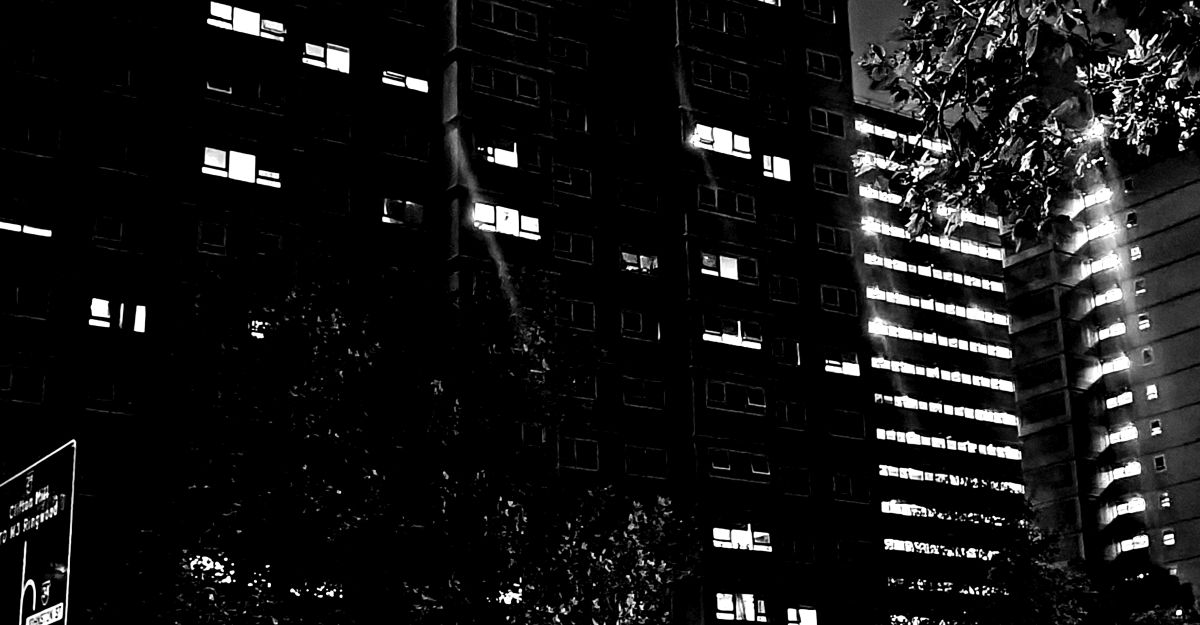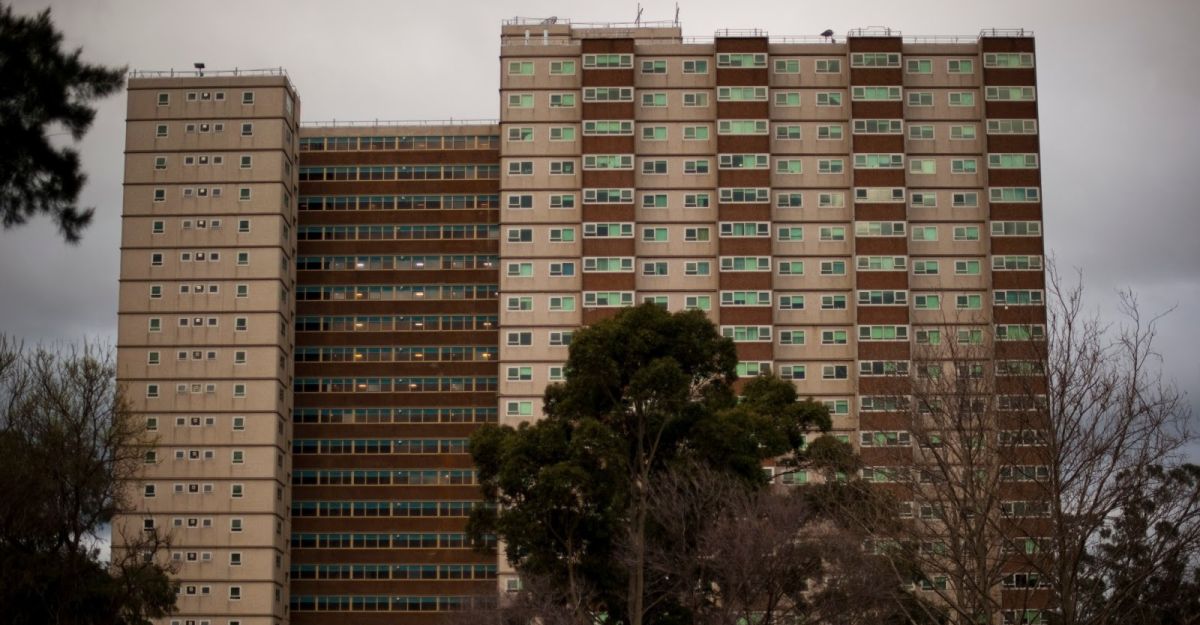On 4 April 2025, Justice Melinda Richards of the Supreme Court of Victoria handed down her decision to dismiss a class action case brought against Homes Victoria by Inner Melbourne Community Legal on behalf of high-rise public housing tenants of the North Melbourne and Flemington estates. Justice Richards’ ruling — pending an appeal by the plaintiff’s legal team — establishes the government’s legal authority to proceed with demolishing the public housing estate communities of Flemington and North Melbourne.
Lead plaintiff Barry Berih is, for now, a tenant at 33 Alfred Street, North Melbourne, one of the three tenanted towers (120 Racecourse Road and 12 Holland Court in Flemington) and two “decanted” towers (20 Elgin Street and 141 Nicholson Street in Carlton) announced in the first tranche of buildings to be demolished and redeveloped as part of the Victorian State Government’s newest urban renewal program. High-rise public tenants, who were blindsided by former Victorian Premier Daniel Andrews’ declaration of the decision to “retire and redevelop” their homes in September 2023, originally brought the case in early 2024. Their claim sought judicial review of the validity of the Victorian Government’s decision, stating that Homes Victoria failed to properly consider tenants’ rights, contravened the Charter of Human Rights and Responsibilities Act 2006 (Vic) with respect to the right to freedom from unlawful and arbitrary interference with one’s home, and failed to consult with tenants prior to making its decision.
Justice Richards ultimately ruled that the tenants’ claim was unsuccessful on all three counts. The court found that Homes Victoria was not required to consult tenants before making the decision, and indeed that consultation would not have made a material difference to Homes Victoria’s “retire and redevelop” decision. Richards also determined that the Charter rights of tenants had been sufficiently considered, and that limitations of tenants’ rights effected by the decision were lawful, reasonable and justified per section 7(2) of the Charter.
If this estate renewal policy is implemented without further challenge, all forty-four public housing towers in Melbourne will be demolished by 2051 at the expense of the current housing security of approximately 10,000 public tenants.
*
Running in parallel to the class action has been an inquiry by the Victorian Legislative Council’s Legal and Social Issues Committee into the government’s decision to redevelop the tower estates, with submissions sought by the end of last month. The simultaneous progression of the class action and Parliamentary inquiry has provided an opportunity to reflect on the way that the human impact of urban renewal policies is only ever afforded post hoc consideration at best. Even if the class action succeeded in securing an injunction on the redevelopment process pending meaningful tenant consultation — and even if the inquiry results in a strident set of recommendations to overhaul tenant engagement by the state government — the damage has been done, and the horizon of political possibilities has been set. Inner city value recapture must proceed at any cost, as must the deflection of critiques of housing and wealth maldistribution via ambitious promises of urban residential densification. After all, as the court identified, there was no realistic possibility that Homes Victoria could have made a different decision.
We argue that the court’s ruling reveals the hard limits of a rights framework operating within a market-driven housing system. The forced relocation of thousands of people — many of whom are low-income migrants and refugees, elderly residents and disabled people — puts a lie to the protections supposedly afforded to public tenants. Instead, it is revealed that on the whim of government, public tenants can be subjected to the most forceful and literal of rug-pulls. Contrary to the promise of indefinite affordable tenure, they now find that they have no legal right to remain in their homes, nor are they guaranteed a voice in decisions made about them. Having endured the violence of decades of managed decline, tenancy residualisation, media stigmatisation, over-policing, state surveillance, and Covid-19 hard lockdowns, tenants of the North Melbourne and Flemington estates have once again been failed.
What is being called “renewal” is, in practice, a reassertion of the bare power of property ownership in service of reconfiguring who is allowed to inhabit the city. National housing reforms, including legislative changes such as the Residential Tenancies Amendment Act 2021 (VIC), incentive packages for private and institutional landlords, and new funding streams for community housing providers, are being rolled out alongside large-scale state-led public housing redevelopment programs.
Together, these reforms are not just bringing about an absolute reduction in public housing and its associated tenure status but reshaping the terms on which tenants relate to landlords across rental tenure types, and, importantly, how tenants relate to each other within and between tenure types at the level of grassroots organising. In this alignment of state bureaucracy, the not-for-profit sector and capital, new methods of value extraction are being actively designed as solutions to the housing crisis.
Attending to the increasing prevalence of appeals to the value of “social mix”, the architecture of public-private partnerships and the rebranding of landlords as “housing providers”, it is possible to begin tracing the contours of a broader political project. These mechanisms serve to rework the economic, social and spatial conditions of dwelling, particularly for those in what was once the most secure form of housing tenure in the country. These interventions target some of the most valuable real estate in Melbourne, not solely because of location, but because of the opportunity it presents to remake the tenant, the neighbourhood, and the (stolen) land itself — an urban experiment in the extraction of value from tenants. To make this all work apparently requires the acceleration of corporate landlordism via the spatial reorganisation of Melbourne’s inner urban demographic profile.
*
The Ground Lease Model (GLM), introduced into the Victorian Government’s renewal repertoire in 2021, enables the state to retain ownership of Crown land while leasing it to a private sector consortium composed of, at minimum, a community housing organisation (CHO) and private developer. CHOs hold landlord rights over these sites for a minimum of forty years. During this period, the arrangement allows for returns to be generated through redevelopment, rent extraction and quarterly service payments that will cost hundreds of billions in public expenditure, but without public scrutiny over how that housing/tenant/class is treated.
The material beneficiaries of this model are corporate landlords: CHOs that expand their portfolios and operating revenue by growing their social, affordable and private housing stock; developers that have now secured a guarantee of public land development for 30 years; and investment funds that capture long-term yield. For the public, the costs are significant. Analysis of the first two GLM projects shows that each additional unit of social housing can cost between $5.2 million and $7.5 million, with replacement stock delayed by payback periods of up to thirty-two years.[1] Dwellings at 141 Nicholson and 20 Elgin Street, Carlton, were vacated in December 2022 but have yet to be demolished, contributing to a protracted period of lost accommodation capacity on this site. The time taken for that lost capacity to be exceed by the cumulative gain is some measure of how far down the road the housing crisis can be kicked. These variations suggest that carefully staged renewal, especially projects that prioritise early delivery of public housing, can reduce the time taken to recoup dwelling capacity and thus better serve system-wide housing need. This is not a strategy to house people — it is a publicly subsidised landlord investment strategy. (For associated propaganda, see this article in reference to the suburb of Flemington.)
Beneath the financial and legal architecture of how these governance arrangements will work lies a set of moral assumptions that justify its operation. Chief among them is the doctrine of “social mix”, the notion that concentrated poverty is itself the problem, and that dispersing public housing tenants among wealthier residents will somehow improve individual life outcomes (see Part Three of this report). This logic draws from sociological theory, particularly the neighbourhood effects thesis, which posits that proximity to disadvantage compounds disadvantage. The policy response, therefore, is not to address poverty directly but to break up residualised tenancies (inevitably, poorer communities) and scatter them (that is, their residents) spatially. This happens alongside and with the same force as the direct undermining of security of tenure, diminished as public tenancy protections are in practice. It’s a hypothesis that blames the places where poverty is, rather than its structural causes, as if poverty is contagious rather than produced.
This thinking underpins much of the tower redevelopment agenda. Public housing residents are displaced not because their homes are unliveable — people live in them now, despite abject failure by their government landlord to invest in their upkeep. It is curious that a structural process of managed decline, or of organised abandonment, that tenants experience every day, becomes obscured in declarations of “not fit for purpose” and “no alternatives to demolition.”
What is at stake in all of this is not just housing and infrastructure, but the kind of city we are (re)building and who gets to belong in it.
Justice Richards noted in her decision that her deliberation involved weighing the impact of demolition on current tenants against the potential benefit to future ones. The future tenant remains, however, hypothetical, while the existing tenant must live through the consequences of the state’s decision now. As always, it is public housing residents who are forced to bear the burden of landlord experiments and policy innovation in affordable housing delivery, and to be thankful for the privilege of being disrespected and displaced.
Real public tenants — people with names, addresses, identifiable communities of place — have been told that limitations on their current rights are an acceptable part of making room for other potential renters whose rights must be safeguarded in advance. At the level of state government, we are supposed to be soothed by the perverse logic that the government must spend housing to build housing, and that it is simply an unfortunate turn of fate that those who must pay the highest price in this process are those with some of the least financial capacity to weather the system shock of housing displacement.
The fact that Homes Victoria may now seek to recover legal costs from a plaintiff who is not only a public tenant, but one that has tried to assert his basic human rights in court against a state decision, is telling. The price of contesting landlord power, even through the narrow channel of legal remedy, is now being passed back to the tenant. In this system, even losing comes at a cost.
[1] Authors’ submission to Inquiry into the redevelopment of Melbourne’s public housing towers (2025).
The three co-authors are team members for an ARC-funded project Precarious Dwelling: encounters with the housing crisis.The project is based at the Centre for Urban Research, RMIT University.
Image: The Collingwood Estate, photographed from the opposite side of Hoddle Street (David Kelly).



